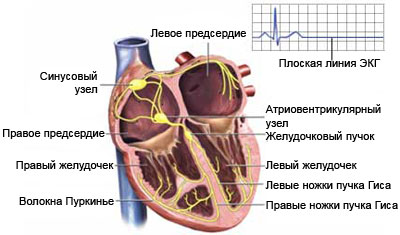Cardiac arrest
Description of cardiac arrest
When cardiac arrest, the heart suddenly stops beating. This occurs due to problems in the electrical system of the heart, which controls its operation. If cardiac arrest should It is immediately provided emergency medical care. If you do not help a person can quickly die, as the blood enters the tissues and organs.
Cardiac arrest and heart attack – Different things. When a person has a heart attack, blood flow to the heart is interrupted. A heart attack can occur because of problems with the coronary arteries, such as the accumulation of plaque, thrombus or thickening of the artery walls.

Causes of cardiac arrest
Can cause cardiac arrest:
- Ventricular fibrillation – fast, irregular heart rhythm, prevents blood circulation (the most common cause of sudden cardiac arrest);
- Ventricular tachycardia – fast, but regular heart rhythm. It may go into ventricular fibrillation;
- Very slow heart rate due to failure of the established kardiostimuljatora or severe heart block (interference with electrical conductivity);
- Respiratory arrest;
- The thrombus or drowning cardiac tissue;
- Exposure to electric current;
- Gipotermiя;
- A sudden drop in blood pressure;
- Unknown causes.
Risk factors for cardiac arrest
Factors, that increase the likelihood of heart failure:
- Coronary artery disease;
- Heart attack;
- Cardiomyopathy;
- The increased size of the heart;
- Congenital heart defects;
- Heart valves do not function properly;
- Disease, Affecting the electrical system of the heart;
- Severe metabolic imbalance;
- Side effects of medications;
- Lung disease;
- Chest injury;
- Severe blood loss;
- Excessive overexertion in people with heart disorders;
- Drugs (eg, cocaine).
Symptoms of cardiac
Symptoms of heart failure include:
- Loss of consciousness;
- Asphyxia;
- The absence of heartbeat.
In just a few weeks prior to cardiac arrest, some patients report the following symptoms or warning signs:
- Chest pain;
- Feeling weak;
- Pounding sensation in the chest;
- Feeling faint.
Diagnosis of heart failure
First, you must check, whether the person is conscious. If the person does not answer, you should immediately call an ambulance pososch. If the stock has an automatic external defibrillator (AVD), you need to use it according to instructions.
After calling the emergency, with the help of the AED should try to run the heart. If an AED is not available, to start to perform chest compressions, pressing on the chest. Push the chest to a depth of at least 4-5 cm, at a rate of at least 100 compressions per minute. If you know how to perform cardiopulmonary resuscitation (SLR), after 30 Contractions have to do two breaths into the lungs. Then, continue chest compressions. Massage should continue until the arrival of an ambulance, or until, the victim has not yet regained consciousness.
Treatment of cardiac
Early treatment improves the chances of survival. Steps, which are designed to increase the survival rate:
Emergency call
We must immediately seek emergency medical help. Call the team, as soon as the notice signs of heart problems or suspect, that cardiac arrest.
Defibrillation in cardiac arrest
Defibrillation – an electric shock to the chest through electrodes or pads. Electroshock is designed to run or stop the heart to correct irregular heartbeat.
Start CPR in cardiac arrest
CPR helps keep blood flow and oxygen to the tissues and the brain, until used other therapies. The heart and brain are very susceptible to low oxygen levels. Damage to these organs can occur even if successful CPR.
Further Medical Treatment
Ambulance at the scene and doctors at the hospital provide essential medical care. Oni appoint drugs, Place the handset, to maintain an open airway, as well as provide emergency medical care. Often used adrenaline, to make the heart more receptive to electrical impulses and improve blood flow to the heart and brain. The patient will be provided with oxygen.
Therapeutic hypothermia – Another type of treatment, which can be used in a hospital. It uses a lowering of the temperature of the human body to 32 ° -34 ° C using a cold wet blanket, ice packs and cool saline. Cooling is performed in order to restore the functions of the brain. The human body can remain at this temperature for a long period of time (about 12-24 hours).
Even in those cases, When a normal heart rhythm was restored, Low oxygen levels may cause serious damage to the heart, brain and other vital organs.
Prevention of cardiac arrest
To reduce the risk of heart failure, it is recommended to do the following:
- Find Out, which can be dangerous signs of heart disease and immediately seek help, if there was any of these;
- Talk to your doctor, If the disease has been diagnosed with heart – eg, your doctor may recommend taking medication to prevent arrhythmia;
- Casual doctor, Do I need a home automatic external defibrillator, if you are at high risk of cardiac arrest.
